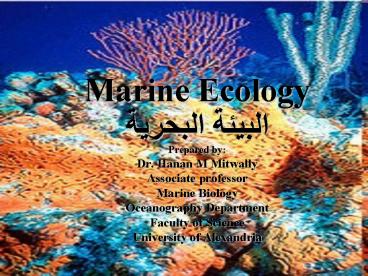Marine Ecology ?????? ??????? - PowerPoint PPT Presentation
1 / 31
Title: Marine Ecology ?????? ???????
1
Marine Ecology?????? ???????
- Prepared by
- Dr. Hanan M Mitwally
- Associate professor
- Marine Biology
- Oceanography Department
- Faculty of Science
- University of Alexandria
2
Objectives
- Definition
- What are the differences between marine Biology
and marine Ecology? - Ecology and Complexity organisms, populations
and communities. - Importance of marine life.
- Marine life forms.
- Marine biology habitats.
- Littoral zone.
- Pelagic zone
3
- What Are The Differences Between Marine Ecology
And Marine Biology?
Use the Adjacent figures To answer the above
question.
4
- Marine biology differs from marine ecology as
Marine Ecology is focused on how organisms
interact with each other and environment. - Marine Biology is the study of the animal itself.
Tide pools with sea stars and Sea
anemones,California
A giant grouper.
5
- What is Marine Biology?
- Marine Biology
- is the scientific study of living organisms in
the ocean or other marine or brackish bodies of
water. - In biology many phyla, families and genera have
some species that live in the sea and others that
live on land. - Each habitat has its own organisms.
6
- What is Marine Ecology?
- Marine Ecology
- is the branch of ecology dealing with the
interdependence of all organisms living in the
ocean, in shallow coastal waters, and on the
seashore. - The marine environment for all organisms consists
of non-living, abiotic factors and living, biotic
factors. - Biotic Factors Vs Abiotic Factors
- The biotic factors are the interactions among
living organisms.
7
Individual Organisms
Population
COMPLEXITY
Community
Ecosystems
Biosphere
8
Abiotic Factors
Dissolved gases
9
- Activity 2 (Abiotic factors)
- ???? ?? ?????? ????? ??????? ????? ???????? ???
???? ?????? - ?????? ???? ??????? ?????????? Physical
- ??????? ???? ??????? ??????????Chemical
- ??????? ???? ??????? ?????????? Geological
- ??? ????? ?????? ??? ???? ?????? ???? ??????
??????.(?? ???? ????? ???????) - ??? ?????? 5 ?????
10
Physical
Abiotic Factors
Chemical
substratum
Dissolved gases
geological
11
(No Transcript)
12
- What Are Marine Life Forms?
- Are they Plants?
- Are they Animals?
- Are they Bacteria?
13
(No Transcript)
14
Marine Bacteria
Zooplankton
Phytoplankton
Zoobenthos Invertebrate animals
Phyto-Benthos Macro-algae
Nekton
15
Marine Biology Habitats
16
(No Transcript)
17
- The Benthic Zone
- Bottom substrate often rich in detritus.
- ?Extends from the seashore to the deepest parts
of the sea. - Organisms that are living on bottom are Benthos.
- Littoral zone starting from the shoreline at the
spray region and moves to the intertidal region
between the high and low water marks, and then
out as far as the edge of the continental shelf.
18
The rocky shoreline showing a clear line, where
high tide occurs.
Littoral zone at a beach..
19
- Supralittoral zone
- Seawater penetrates these elevated
- areas only during storms with high tides.
Organisms must adapted with
20
- Intertidal zone
- It is the area that is exposed to air at
- low tide and submerged at high tide.
- This area can be
- Steep rocky cliffs.
- Sandy beaches.
- or wetlands (e.g., vast mudflats).
- The area can be
- Narrow strip, (Mediterranean sea) that have only
a narrow tidal range. - Many meters of shoreline (Red Sea).
Low tide zone in California
Barnacles limpets in the intertidal zone
21
- Zonation of Intertidal zone
- Marine biologists and others divide the
intertidal region into three zones (low, middle,
and high), based on the overall average exposure
of the zone.
22
A rock, seen at low tide, exhibiting typical
intertidal zonation.
Mussels in the intertidal zone in, England.
23
- Mediterranean Sea
Red Sea
- Mediterranean sea is tide-less sea.
- The level of tide at most Egyptian Mediterranean
coasts - lt 0.5m.
Red Sea tide ranges between 0.6 m in the north,
near the mouth of the Gulf of Suez and 0.9 m in
the south near the Gulf of Aden.
24
Some intertidal organisms
25
- Subtidal Zone
- The areas where sunlight reaches the ocean floor.
- The water is never so deep as to take it out of
the photic zone. - This results in high primary production and makes
the subtidal zone the location of the majority of
sea life.
26
- The word pelagic comes from
- the Greek pélagos, open sea.
27
- Neritic zone
- It is extending from low tide mark to the edge of
the continental shelf. - Characters of Neritic zone
- Shallow depth 200 meters.
- well-oxygenated water
- Low water pressure.
- Stable temperature and salinity levels.
- High photosynthetic activities from phytoplankton
and floating sargassum . - At the edge of the neritic zone, the continental
shelves end rapidly descending to the deeper
oceanic crust and the pelagic zone.
28
- Oceanic zone
- Any water in the sea that starts beyond the
continental shelves. - offshore, high light levels, upper regions of
water column - Conditions change with depth
- the pressure increases and there is less
light.
29
Creatures of Neritic Zone A-Free floating
creatures Microscopic phytoplankton Zooplankt
on. B- Nekton Fish and their larvae.
Small crustaceans.
30
- Summary
31
- Take Home Message
- Success Is An Energy Inside us God Supports It.































